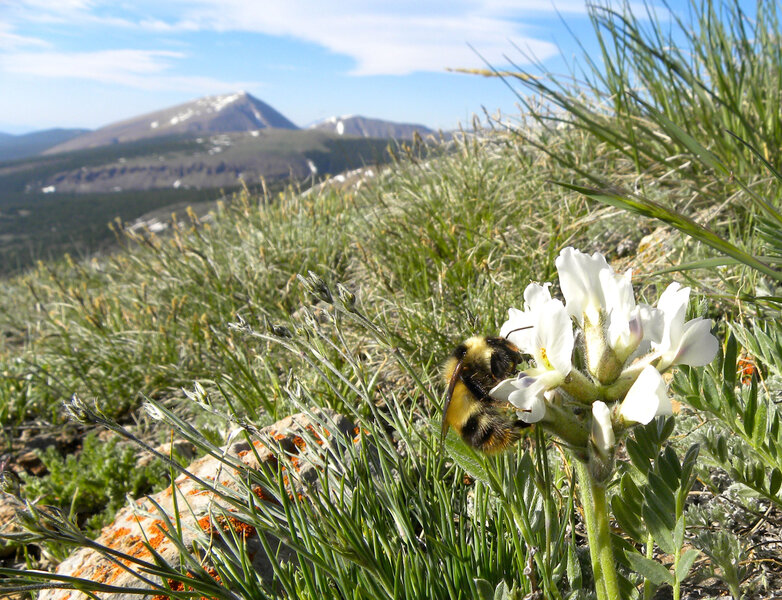Bees' tongues are shrinking, and now scientists know why
Loading...
Why are bee populations declining?
The question has haunted scientists, farmers, and gardeners for years, and has prompted city-dwelling Millennials from New York to Portland to don bee suits and become urban beekeepers.
Researchers have now found one more piece of the puzzle: Bumble bee tongues are shrinking.
Why? Not for any of the obvious reasons. "It was not a result of decreasing body size, competition from invaders, or co-evolution with flowers in the area," explains SUNY biologist Nicole E. Miller-Struttmann and her colleagues, who examined data reaching from 1960 to 2014, in a press release.
"Instead, it is a result of warming summers, which reduced numbers of the deep flowers these species preferred, forcing the insects to be general foragers capable of feeding across remaining flowers, including many shallow flowers."
The key? Overspecialization. The longer the tongue, the deeper the flower that the bees drink from and pollinate. As summers warm, shorter-tongued bees that can sip from a variety of flowers are doing better than bees that require flowers with deep tubes, explained the researchers in an article appearing in the latest issue of Science, so the bumble bees' tongues are shrinking and the populations of their short-tongued cousins are growing.
Those increasing temperatures – 2014 was the hottest year on record, and 2015 is on track to top it – are wreaking havoc on the flower populations, say the scientists. Summer temperatures just 3 degrees C (5 degrees F) above average can inhibit flower growth, they found. Between 1960 and 1985, only four summers got hot enough to cause problems for flowers. Since 1985, fully half of the summers are too hot for abundant flowering.
The warmer temperatures also mean that the once-barren summits are now more flower-friendly, but that's not enough to make up for the losses, say researchers.
"Declines in flowering [affect] the majority of the mountain landscape; in these extensive habitats, millions of flowers were lost. Thus, even with gains of a few thousand flowers on the summit, total food resources for alpine bumble bees on Pennsylvania Mountain have fallen by 60% since the 1970s," they write.
As flower populations shrink, bumble bees are forced to broaden their diet and, at the same time, compete with the shorter-tongued bees that have started encroaching on their turf.
The researchers are concerned about what this decline could signal for larger trends across bee populations and flower ecosystems. Long-tongued bees evolved in symbiosis with the deep-tubed flowers that used to fill their landscapes. Now that their population is declining, their mountain homes are reshuffling the ecological deck.
These problems are not exclusive to bumble bees in the mountains of Colorado, where Dr. Miller-Struttmann and her colleagues focused their work.
Between May 2014 and April 2015, managed honey bee populations in the US dropped by more than 40 percent, on top of a 35 percent decline the previous year, reported The Christian Science Monitor.
Declining honey bee populations would affect up to 75 percent of domestic produce, Greenpeace reports, with apples, strawberries, tomatoes, and almonds among the hardest-hit crops.
Colony collapse disorder, in which queens and young populations are mysteriously left behind by disappearing worker bees, is believed to be a negative outcome of pesticide use. Fortunately, colony collapse appears to be on the decline. In 2008, about 60 percent of the hives lost over the winter were attributed to CCD, but the 2014-2015 winter saw no new reports of collapse.
For now, evolution is helping Colorado's wild bumble bees keep pace with climate change, say the authors of the new Science paper. Is that enough?
"They have adapted to diminished resource levels, a major impact of climate change," writes senior author Candace Galen in an email to the Monitor.
"However, climate change isn’t 'one dimensional.' As high altitudes warm, there may be other threats to the alpine bumble bee species that we typically associate with warmer conditions: pathogens, parasites moving up as subalpine bumble bees move in," she adds. "I am an optimist, so I see the glass as half full. But we have to stop tipping it over (so to speak)!"








